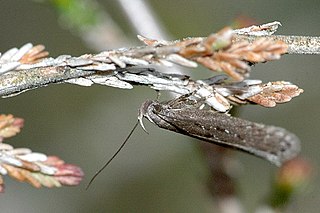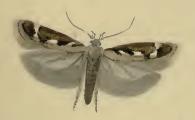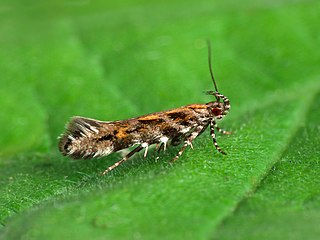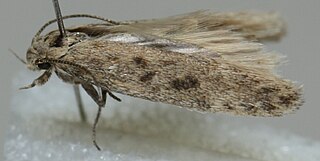
Elachista argentella is a moth of the family Elachistidae found in all of Europe, except the Balkan Peninsula.

Neofaculta ericetella is a moth of the family Gelechiidae. It is found in Europe and Asia Minor.

Recurvaria leucatella is a moth of the family Gelechiidae. It is found in most of Europe, Turkey, Central Asia and the Caucasus.

Simyra albovenosa, the reed dagger, is a moth of the family Noctuidae. It is found in most of Europe, then Turkey, Iran, Transcaucasus and into the east Palearctic.

Chrysoesthia sexguttella, the orache leafminer moth, is a moth in the family Gelechiidae. It is found in all of Europe, east to southern Siberia, as well as the north-eastern parts of North America, where it might be an introduced species.

Elachista subalbidella is a moth of the family Elachistidae found in Europe and North America.

Elachista albidella is a moth of the family Elachistidae, described by William Nylander in 1848. Its wingspan ranges from 9–10 millimetres (0.35–0.39 in).The head is white. Forewings are white, costa and sometimes dorsum suffused with fuscous; plical stigma large, elongate, black ; an angulated fuscous fascia beyond middle, angle acutely produced towards apex ; small fuscous costal and dorsal spots near apex. Hindwings are rather dark grey.The larva is greenish-grey, more yellowish anteriorly; head dark brown.

The lobster-clawed moth is a moth of the family Gelechiidae. It is found in most of Europe, except for the Iberian Peninsula and most of the Balkan Peninsula. In the east, the range extends to Siberia and Taiwan.

Caryocolum marmorea is a moth of the family Gelechiidae. It is found from Scandinavia to the Mediterranean islands, and from Ireland to Poland, Hungary and Greece. It is also found on the Canary Islands and Madeira. It is also found in North America.

Caryocolum viscariella is a moth of the family Gelechiidae. It is found in Ireland, Great Britain, Fennoscandia, Denmark, Germany, France, Switzerland, Austria, Hungary, Italy, Estonia and Russia.

Scrobipalpa costella is a moth of the family Gelechiidae. It is found in western Europe.

Aristotelia ericinella is a moth of the family Gelechiidae. It is found in most of Europe, except most of the Balkan Peninsula.

Mirificarma mulinella is a moth of the family Gelechiidae. It is found in most of Europe, except Finland, the Baltic region and part of the Balkan Peninsula. It has also been recorded from North Africa.

Athrips tetrapunctella is a moth of the family Gelechiidae. It is found in France, Great Britain, Ireland, Fennoscandia, Denmark, Estonia, Latvia, Russia and Ukraine. In the east, the range extends through the southern Ural and Siberia to Primorsky Krai.

Metzneria metzneriella is a moth of the family Gelechiidae. It is widely distributed throughout Europe, as well as Turkey and southern Siberia. The habitat consists of dry pastures and calcareous soils.

Ptocheuusa paupella, the light fleabane neb, is a moth of the family Gelechiidae. It is found from central and southern Europe to the Ural Mountains. It is also found in Turkey and India.

Gelechia rhombella, the apple groundling, is a moth of the family Gelechiidae. It is found in Europe, the Caucasus, Transcaucasia, southern Siberia, the Russian Far East, Korea and China.

Scrobipalpa obsoletella, the summer groundling, is a moth of the family Gelechiidae. It is found in most of Europe, Turkey, the Caucasus, from Iran to Asian Russia (Transbaikal) and Mongolia. It has also been recorded from New Zealand, South Africa and North America, where it is probably an introduced species. The habitat consists of coastal salt marshes and sandy beaches.

Scrobipalpa instabilella, the saltern groundling, is a moth in the family Gelechiidae. It was described by John William Douglas in 1846. It is found in on the Canary Islands, in Algeria, Ireland, Great Britain, Portugal, Spain, France, Belgium, the Netherlands, Germany, Denmark, Italy, Sardinia, Sicily, Greece, Cyprus and Palestine. It is also present in the United States, where it has been recorded from California.

Syncopacma sangiella, the brown sober, is a moth of the family Gelechiidae. It was described by Henry Tibbats Stainton in 1863. It is found in most of Europe, except the Benelux, Denmark and parts of the Balkan Peninsula.


















